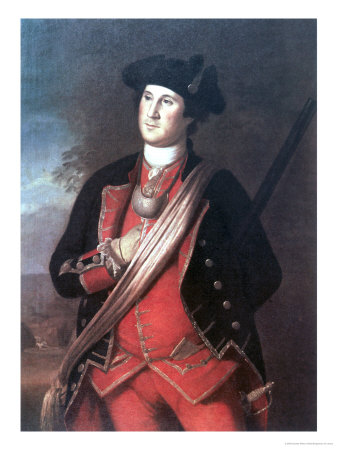
George Washington as a colonel in the Virginia militia, painted in 1772 by artist, soldier, and naturalist Charles Willson Peale (1741–1827). Peale produced more than 50 portraits of Washington.
May 28, 1754 – In the first engagement of the French and Indian War, a Virginia militia under 22-year-old Lieutenant Colonel George Washington defeats a French reconnaissance party in southwestern Pennsylvania. In a surprise attack, the Virginians killed 10 French soldiers from Fort Duquesne, including the French commander, Coulon de Jumonville, & took 21 prisoners. Only one of Washington’s men was killed.
In October 1753, to counter French “aggression” into the Ohio Country, Lieutenant Governor Robert Dinwiddie of Virginia dispatched a 21-year-old, untried colonial militia officer into the western wilderness to deliver an official letter that insisted the French remove themselves from the Ohio Country. The young colonel soon took his first walk on the stage of U.S. history: His name was George Washington, and he already had knowledge of the region from his time as a surveyor’s apprentice.
Taking only a small party along, Washington marched into the heavily forested lands of western Virginia and Pennsylvania with his message from Dinwiddie. He reached Fort LeBoeuf, where he was politely received and then dismissed. The French were in the Ohio Country to stay and had, in fact, taken over a fort that a group of Virginians had been constructing at the headwaters of the important Ohio River.
Dinwiddie sent Washington back into the region the following spring, this time to march to the fort his fellow Virginians were constructing. (In the meantime, the French had taken it over and named it Fort Duquesne.) The young Virginian headed to the northwest escorted by 160 armed militiamen.
Along the way, Washington, now a lieutenant colonel, encountered a group of Mingo Indians under the leadership of a sachem named Tanaghrisson, or “Half King.” Tanaghrisson hated the French, claiming that they had captured, boiled, and eaten his father. He informed Washington that the fort he was headed for was already in the hands of 1,000 French Canadians. He also told him that a party of Frenchmen was close by, numbering about 32 in all. Although he had orders not to act as the aggressor during his march into the wilderness, Washington decided to surprise attack the French group.
A FATEFUL DECISION
On May 28, 1754, Washington and his men met the French in an early morning attack. The French became aware of the Virginians’ advance and, during a few tense moments, both sides had opened fire. It is not even clear which side fired the first shots. The fight went in Washington’s favor, with 14 Frenchmen wounded or killed, and no Virginian casualties. Soon Washington was locked in surrender negotiations with the captured leader of the French party, Joseph Coulon, the Sieur de Jumonville (the young lieutenant colonel spoke no French). All had gone well so far, but suddenly Tanaghrisson turned on the French captives, his men ready to take their scalps. Before Washington could stop his Indian allies, Tanaghrisson killed the French leader with a war club. (The Half King’s motivation is not certain. Perhaps he was trying to incite a larger scale conflict.) Washington’s quick little wilderness battle had become a frontier massacre.
Tanaghrisson and his men abandoned Washington. According to historian James L. Roark, the Indian leader later stated of the young Virginian: “The Colonel was a goodnatured man, but had no experience; he took upon him to command the Indians as his slaves, [and] would by no means take advice from the Indians.” Washington had little choice but to continue his march, even though he feared the few French who had escaped the fight would soon tell their story and the French would march out to meet him with a superior force. About 60 miles (100 kilometers) short of Fort Duquesne, Washington and his men stopped to build a makeshift fort of their own. Reinforcements brought their numbers to more than 300 men.
UNDER ATTACK
On July 3 the French attacked. The French and their Indian allies found Washington’s men unprepared, with many sick and hungry. The fort was not finished and had been built in a poor, low-lying location. Recent rains had left much of the Virginians’ powder wet. Thirty of Washington’s men were killed and another 70 were wounded. The young militia officer surrendered to the French the following day, July 4. When Washington signed the surrender documents, which were in French, he did not know that he was admitting to wantonly killing a French ambassador, namely Jumonville. As the papers made their way from Canada to Paris and to other European capitals, the name “George Washington” was soon seen as one of treachery and murder. Washington was not famous, but infamous.
In reality, Jumonville was not a professional diplomat. He had actually been sent into the Pennsylvania wilderness with a message to the Virginia governor, just as Washington had carried a message from the Virginia lieutenant governor the previous year. Yet the story was told, and the French reacted directly to the wilderness attack on one of their own on western soil they also considered their own. Events accelerated, and Great Britain and France fell into war with one another.